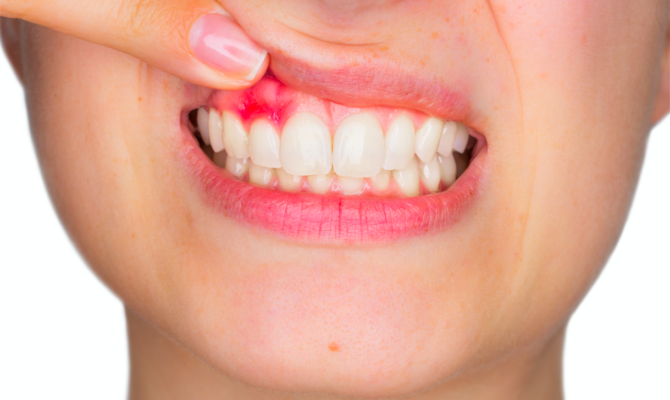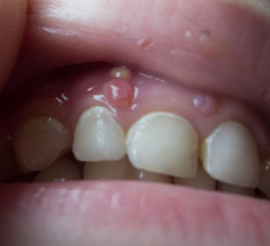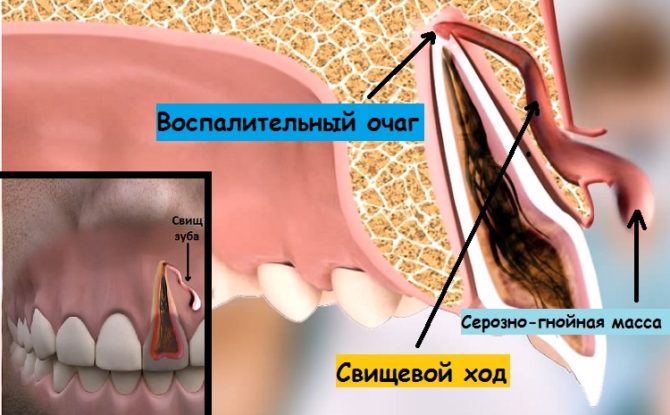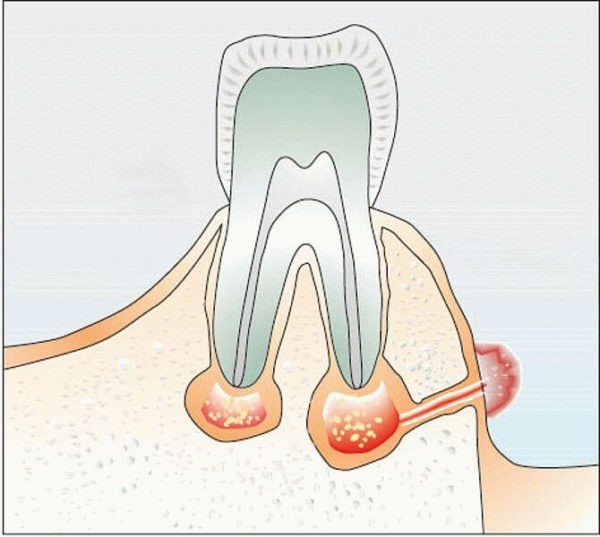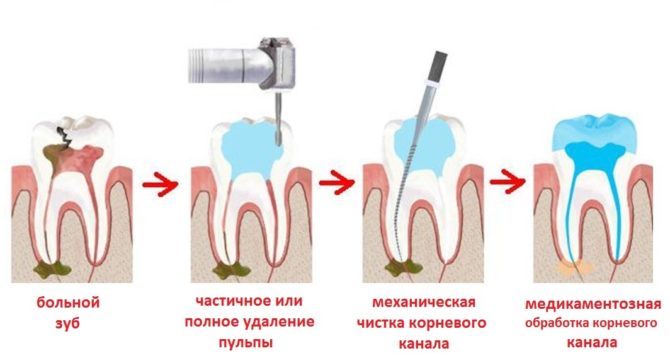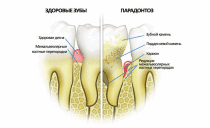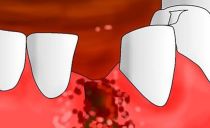Fistula on the gum: causes, treatment
Gingival fistula is a painful symptom that indicates the presence of a focus of inflammation behind the apex of the tooth root. The disease is characterized by a wave-like course: periods of exacerbation alternate with remission and can lead to tooth loss or the spread of infection throughout the body.
Treatment of a fistula on the gum cannot be carried out at home, since it is only a symptom and indicates the development of a pathological process deep in the jaw. You can get rid of the disease only with the help of a set of procedures prescribed by the dentist.
Content
Causes
The appearance of a fistula indicates the presence of soft tissue infection, may occur as a result of improper treatment or its absence at all. In extremely rare cases, the pathological process arises after implantation or tooth extraction.
The main causes of fistula on the gum:
- The most common cause of the disease is the development of an infectious process behind the root of the tooth. This situation occurs in the absence of treatment for caries, when pathological microorganisms enter the dental nerve and eventually spread over its channels. As a result, granulating periodontitis occurs - inflammation of the connective tissue between the root of the tooth and the cortical bone plate. Very often this phenomenon occurs in advanced cases when a person knew about the presence of a long-existing cavity in the tooth, but did not go to the doctor for treatment.
- Fistula of the tooth may occur due to improper treatment, when the channels were cleaned poorly, or antiseptic treatment was not effective. In this case, although the canals are treated, the infection continues to progress in the oral cavity.
- Fistula can form due to perforation of the root of the tooth with improper treatment, trauma. And also against the background of a granuloma or cyst, due to the spread of infection from nearby foci, for example, with sinusitis, abscess, phlegmon.
Symptoms and external signs
The disease can exist for a long period and only periodically make itself felt, such manifestations are called exacerbation. During the period of exacerbation, the symptoms will disturb the patient very much, during the period of remission, unpleasant sensations, discomfort in the causal area, discoloration of the tooth and tooth mobility can occur. On the gum there will be traces and scars from fistulous passages.
A fistula on the gum looks like a small wound, pimple, or swelling in the area of the projection of the apex of a diseased tooth. The formation looks like a small red inflamed area, often with the growth of granulations. Pus or bloody contents may come out of the fistulous course.
Local symptoms of the disease in the acute stage:
- Pain occurs in the affected area of the jaw.
- Pain, discomfort when biting food.
- A tooth may have a filling or a large carious cavity.
- Tooth mobility.
- A pimple inflames and erupts on the gum.
- From pathological education, the contents are allocated.
- The mucous membrane is red or cyanotic.
- Putrid odor from the oral cavity.
- Swelling and swelling of the gums.
- Discomfort during eating, especially hot.
In acute manifestations of fistula in the mouth, an adult can cause general symptoms: fever, impaired well-being, enlarged regional lymph nodes, migraine, headache, weakness.
Types of entities
The disease can be of several types:
- Symptom of granulating periodontitis or other inflammatory process on the root. Appears with the spread of bacterial infection deep into the tissues.
- Fistula on the gum after tooth extraction is a rather rare disease that occurs if a purulent lesion remains in the tissues after extraction. Most often, at the end of the procedure, the fistula disappears, but there are cases when the disease worsens. To eliminate an unpleasant symptom, you need to visit a dentist-surgeon who will cleanse the wound, revise, drain and eliminate the infection.
- Fistula under the tooth crown appears with poor-quality treatment of canals. Removal of the structure and the correct treatment are required.
- The formation of a pathological hole after implantation. It occurs with infection of tissues during surgery and is extremely rare.
What is dangerous fistula on the gum
The disease indicates the presence of infection and acute inflammatory process in the tissues of the jaw. It can lead to pathological disorders in adjacent tissues, to tooth loss, damage to neighboring teeth, and destruction of bone tissue. However, a fistula on the gum is not only dangerous. If the infection continues to spread deep into the tissues, more serious consequences may occur:
- Periostitis is an acute inflammation of the periosteum.
- Osteomyelitis is an inflammation of the bone.
- Sepsis is the spread of infection throughout the body.
- Suppuration of a cyst or granuloma.
- Sinusitis - inflammation of the maxillary sinus.
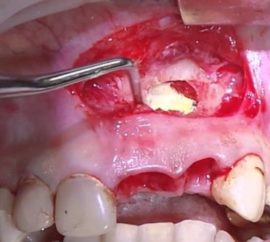 You can not ignore the trip to the doctor and independently treat the disease, not knowing the reasons for its formation, since fistulas on the gum are fraught with complications (see photo). If you consult a specialist in a timely manner, the disease will have a favorable prognosis: dentists will be able to eliminate the pathological process and save a bad tooth.
You can not ignore the trip to the doctor and independently treat the disease, not knowing the reasons for its formation, since fistulas on the gum are fraught with complications (see photo). If you consult a specialist in a timely manner, the disease will have a favorable prognosis: dentists will be able to eliminate the pathological process and save a bad tooth.
Inaction is also impossible, since the fistula on the gum cannot pass by itself. As a symptom, the fistulous course can heal after the release of purulent exudate, but chronic inflammation in the tissues does not go away on its own and eventually makes itself felt again. If the wound on the gum has disappeared, this does not mean that the disease has passed. In order to fully eliminate the pathology, a long, comprehensive treatment with a specialist should be carried out.
Sometimes the disease does not appear before the onset of the fistulous course. A person may not notice tooth decay, which for a long period will destroy the tooth. With the transition of the infection to the nerve, acute pain symptoms occur, but sometimes they do not appear much, and the patient does not pay attention to them.
Such situations arise with the wisdom tooth, which is often located incorrectly and does not receive the necessary hygienic care. Root canals of the third molar are rarely treated because of the inconvenient location and complex anatomy, therefore it is often necessary to remove the wisdom tooth, since the fistula is dangerous with its complications.
Fistula during pregnancy
While waiting for the baby, women are susceptible to various infections and diseases, as hormonal changes and changes occur in their body. A decrease in immune defense can lead to exacerbation of chronic diseases. In addition to such reasons, fistula on the gum during pregnancy can occur after incorrect dental treatment, in the presence of cysts, dental diseases.
In order not to expose a pregnant woman to additional stress, the dentist chooses a special treatment tactic. A full course should include drug therapy, including the use of antibiotics, so doctors often postpone treatment for the period when the child is born.
In an acute situation in the oral cavity, when a purulent fistula appears on the gum, doctors provide the necessary first aid: open a diseased tooth, clean the root canals, carry out massive antiseptic treatment, and give pus outflow. And then they prescribe treatment at home: rinses, oral baths to eliminate the infection.
What to do when there is a fistula on the gum
If the first manifestations of the disease occur, you should make an appointment with the dentist. Before admission, you need to prepare an answer to 3 questions - when, how and where the education arose - so that later you can correctly explain everything to the doctor. Inaction before visiting a specialist is optional, you can rinse your mouth with antiseptics or decoctions of medicinal herbs.
Treatment of a fistula in a tooth is one of the most difficult dental procedures, which involves cleansing the root canals, local and general drug effects on the lesion. Even with the right and high-quality therapy, it is not always possible to achieve the desired result. In this case, surgery is performed.
To save the patient from the fistula, carry out the following types of treatment:
- Therapeutic.
- Surgical
- Physiotherapeutic.
- Medication.
- At home.
Often in dentistry, combined or complex procedures are performed, several types of treatment are prescribed that complement and stimulate each other. The treatment for an adult will be different from that for children. All the recommendations of a specialist should be followed in order to successfully get rid of the disease. Remotely treating is not effective.
Therapeutic procedures
To eliminate the pathological formation requires 3-4 visits to the dentist. Heal fistula on the gum begins with therapeutic procedures. The doctor conducts an examination, palpation, percussion of a diseased tooth, collects an anamnesis. If necessary, appoints additional research methods, for example, radiography. After determining the cause of the disease and making the diagnosis, the necessary procedures are carried out:
- The tooth is cleared of carious decay, or the old filling is removed.
- The root canal system is cleaned using special tools.
- High-quality antiseptic treatment.
- Depending on the situation, the canals are left open for rinsing or medication is applied in them, a temporary seal is placed.
- At the next visit, re-treatment is carried out, disinfectants and antiseptics are used.
- If purulent exudate is absent, temporary filling of the channels with calcium-containing preparations is carried out.
- With a favorable outcome, after 1-2 months, the canals are filled with permanent materials and a seal is installed.
Surgical procedures
The lack of treatment for fistula on the gum has complex consequences, which often lead to surgical intervention. To eliminate the focus of infection, a resection of the apex of the root of the diseased tooth, the entire causative root or the whole tooth is performed.
The latter option is resorted to only as a last resort: when the therapy is not effective and complications arise that are dangerous to the patient’s health, which happens in advanced cases or with diseases of the immune system. Resection of the root or its apex is an effective operation that requires experience and special skills from a doctor.
Physiotherapeutic procedures
For the treatment of dental fistula, physiotherapy is prescribed as additional procedures. Applied electrophoresis of drugs, ultraphonophoresis, fluctuation, darsonvalization. These manipulations contribute to the elimination of pathogenic microorganisms, reduce tissue inflammation, promote wound healing, stimulate blood flow and local immunity.
Drug therapy
The dentist must prescribe medications for a comprehensive effect on the disease.Depending on the clinical situation, the treatment of the fistula on the gum should be carried out with the help of antibiotics, painkillers, anti-inflammatory drugs, vitamin and mineral complexes.
Fistula can be removed only by means of drugs that affect pathogenic microflora. Therefore, the doctor must determine the pathogen and develop treatment tactics.
Most often prescribed Amoxiclav, Amoxicillin, Flemoxab solutab, which effectively fight the disease. Antibiotic therapy should last from three to seven days.but not more than a week.
Folk remedies
Additional treatment for fistula on the gum should be carried out at home:
- Rinsing the oral cavity with antiseptic drugs.
- Rinsing with decoctions of medicinal herbs: eucalyptus, oak bark, sage, calendula, yarrow, chamomile.
- Soda-salt rinses to eliminate pus.
- Carrying out oral baths with drugs.
- Applying gels and pastes to the gum with an antimicrobial, antiseptic effect.
- Local application of wound healing remedies.
It is impossible to cure a fistula on the gum at home without visiting a dentist. Education is only a symptom, and the disease progresses somewhere in the middle of the jaw. Only a specialist can achieve full recovery of the patient with the help of a complex of various procedures.
It can be concluded that fistula is a symptom of a more serious oral disease. You can not treat the disease yourself. To maintain healthy teeth and the body, you need to contact a specialist and undergo full therapy. With timely treatment of pathology, you can get rid of quickly and forever.

